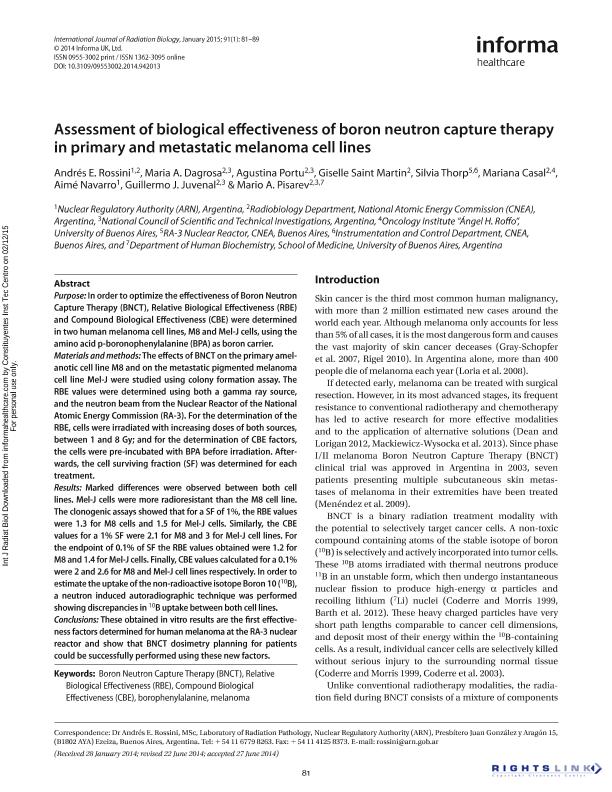Mostrar el registro sencillo del ítem
dc.contributor.author
Rossini, Andrés Eugenio

dc.contributor.author
Dagrosa, María Alejandra

dc.contributor.author
Portu, Agustina Mariana

dc.contributor.author
Saint Martin, María Laura Gisela

dc.contributor.author
Thorp, Silvia Inés

dc.contributor.author
Casal, Mariana
dc.contributor.author
Navarro, Aime
dc.contributor.author
Juvenal, Guillermo Juan

dc.contributor.author
Pisarev, Mario Alberto

dc.date.available
2018-02-07T13:31:23Z
dc.date.issued
2014-08
dc.identifier.citation
Rossini, Andrés Eugenio; Dagrosa, María Alejandra; Portu, Agustina Mariana; Saint Martin, María Laura Gisela; Thorp, Silvia Inés; et al.; Assessment of biological effectiveness of boron neutron capture therapy in primary and metastatic melanoma cell lines; Taylor & Francis Ltd; International Journal Of Radiation Biology; 91; 1; 8-2014; 81-89
dc.identifier.issn
0955-3002
dc.identifier.uri
http://hdl.handle.net/11336/35931
dc.description.abstract
Purpose: In order to optimize the effectiveness of Boron Neutron Capture Therapy (BNCT), Relative Biological Effectiveness (RBE) and Compound Biological Effectiveness (CBE) were determined in two human melanoma cell lines, M8 and Mel-J cells, using the amino acid p-boronophenylalanine (BPA) as boron carrier. Materials and methods: The effects of BNCT on the primary amelanotic cell line M8 and on the metastatic pigmented melanoma cell line Mel-J were studied using colony formation assay. The RBE values were determined using both a gamma ray source, and the neutron beam from the Nuclear Reactor of the National Atomic Energy Commission (RA-3). For the determination of the RBE, cells were irradiated with increasing doses of both sources, between 1 and 8 Gy; and for the determination of CBE factors, the cells were pre-incubated with BPA before irradiation. Afterwards, the cell surviving fraction (SF) was determined for each treatment. Results: Marked differences were observed between both cell lines. Mel-J cells were more radioresistant than the M8 cell line. The clonogenic assays showed that for a SF of 1%, the RBE values were 1.3 for M8 cells and 1.5 for Mel-J cells. Similarly, the CBE values for a 1% SF were 2.1 for M8 and 3 for Mel-J cell lines. For the endpoint of 0.1% of SF the RBE values obtained were 1.2 for M8 and 1.4 for Mel-J cells. Finally, CBE values calculated for a 0.1% were 2 and 2.6 for M8 and Mel-J cell lines respectively. In order to estimate the uptake of the non-radioactive isotope Boron 10 (10B), a neutron induced autoradiographic technique was performed showing discrepancies in 10B uptake between both cell lines. Conclusions: These obtained in vitro results are the first effectiveness factors determined for human melanoma at the RA-3 nuclear reactor and show that BNCT dosimetry planning for patients could be successfully performed using these new factors.
dc.format
application/pdf
dc.language.iso
eng
dc.publisher
Taylor & Francis Ltd

dc.rights
info:eu-repo/semantics/openAccess
dc.rights.uri
https://creativecommons.org/licenses/by-nc-sa/2.5/ar/
dc.subject
Boron Neutron Capture Therapy (Bnct)
dc.subject
Relative Biological Effectiveness (Rbe)
dc.subject
Compound Biological Effectiveness (Cbe)
dc.subject
Borophenylalanine
dc.subject
Melanoma
dc.subject.classification
Otras Medicina Básica

dc.subject.classification
Medicina Básica

dc.subject.classification
CIENCIAS MÉDICAS Y DE LA SALUD

dc.title
Assessment of biological effectiveness of boron neutron capture therapy in primary and metastatic melanoma cell lines
dc.type
info:eu-repo/semantics/article
dc.type
info:ar-repo/semantics/artículo
dc.type
info:eu-repo/semantics/publishedVersion
dc.date.updated
2018-02-06T20:07:35Z
dc.journal.volume
91
dc.journal.number
1
dc.journal.pagination
81-89
dc.journal.pais
Reino Unido

dc.journal.ciudad
Londres
dc.description.fil
Fil: Rossini, Andrés Eugenio. Comisión Nacional de Energía Atómica; Argentina
dc.description.fil
Fil: Dagrosa, María Alejandra. Consejo Nacional de Investigaciones Científicas y Técnicas; Argentina. Comisión Nacional de Energía Atómica; Argentina
dc.description.fil
Fil: Portu, Agustina Mariana. Consejo Nacional de Investigaciones Científicas y Técnicas; Argentina. Comisión Nacional de Energía Atómica; Argentina
dc.description.fil
Fil: Saint Martin, María Laura Gisela. Consejo Nacional de Investigaciones Científicas y Técnicas; Argentina. Comisión Nacional de Energía Atómica; Argentina
dc.description.fil
Fil: Thorp, Silvia Inés. Comisión Nacional de Energía Atómica; Argentina
dc.description.fil
Fil: Casal, Mariana. Comisión Nacional de Energía Atómica; Argentina. Universidad de Buenos Aires. Facultad de Medicina. Instituto de Oncología "Ángel H. Roffo"; Argentina
dc.description.fil
Fil: Navarro, Aime. Autoridad Regulatoria Nuclear; Argentina
dc.description.fil
Fil: Juvenal, Guillermo Juan. Consejo Nacional de Investigaciones Científicas y Técnicas; Argentina. Comisión Nacional de Energía Atómica; Argentina
dc.description.fil
Fil: Pisarev, Mario Alberto. Consejo Nacional de Investigaciones Científicas y Técnicas; Argentina. Comisión Nacional de Energía Atómica; Argentina. Universidad de Buenos Aires. Facultad de Medicina. Departamento de Bioquímica Humana; Argentina
dc.journal.title
International Journal Of Radiation Biology

dc.relation.alternativeid
info:eu-repo/semantics/altIdentifier/doi/http://dx.doi.org/10.3109/09553002.2014.942013
dc.relation.alternativeid
info:eu-repo/semantics/altIdentifier/url/http://www.tandfonline.com/doi/full/10.3109/09553002.2014.942013
Archivos asociados
